Ventilation in the bathroom and toilet: operating principle, typical diagrams and installation features
The bathroom and toilet are rooms in the process of arranging which, first of all, you need to think about organizing intensive air exchange. This is due to the specific nature of the operation of hygienic premises.Polluted and over-humidified air must be freely removed and replaced with a fresh portion.
We will tell you how ventilation should be arranged in the bathroom and toilet according to building codes and regulations. In the article we presented, the options for organizing ventilation that have been tested in practice are analyzed in detail. Do-it-yourselfers will find detailed installation manuals here.
The content of the article:
- Why is ventilation needed?
- Sanitary requirements and standards
- The difference between natural ventilation and forced ventilation
- Calculation of optimal performance
- Classification of exhaust fans
- Basic criteria for choosing equipment
- Additional equipment functions
- System components and materials
- Installation of ventilation in the bathroom and toilet
- Recommendations from experienced specialists
- Rules for operating the exhaust system
- Conclusions and useful video on the topic
Why is ventilation needed?
The opinion that the absence of a ventilation shaft in the bathroom and toilet will only lead to fogging of the mirrors is fundamentally wrong. The main problem is the appearance of fungus (most often it can be seen on the seams between tiles) and rust on the surface of equipment and furniture.
Often, it is due to an incorrectly designed ventilation system that corrosion affects the working parts of the washing machine, which is the cause of its breakdown. The list of problems that the lack of intensive air exchange leads to does not end with this. As a result, poor ventilation will have a detrimental effect on the health of residents.
Sanitary requirements and standards
There are special standards that must be followed when organizing forced air exchange in rooms with high humidity levels. At a minimum, you need to ensure a fresh air flow of 6-7 m3/hour for each cubic meter of bathroom and about 8-10 m3/hour - for a toilet or a combined bathroom.

The difference between natural ventilation and forced ventilation
There is natural and forced ventilation. In the first case, air exchange is ensured by the circulation of air masses through door and window openings. About a century ago, natural ventilation was considered the most effective method.
Today, it is unable to provide a sufficient level of air exchange, so it is used only for inflow. To fully ventilate the room, choose the forced option. After all, no one wants to open a window for a long time in winter and let out the heat.
Organizing forced ventilation involves installing an exhaust fan. Thanks to this, you can retain precious heat, remove excess moisture and fill the room with fresh and clean air in a matter of minutes.
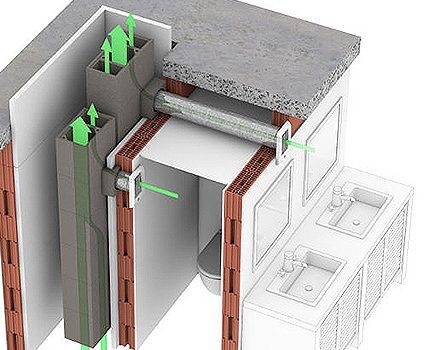
Calculation of optimal performance
Before going to the store and purchasing equipment for installing forced ventilation in the toilet and bathroom, you need to make some calculations.To select the equipment that is optimal for performance, you need to know the exact volume and type of room.
Each room has its own air exchange rate. This characteristic shows how many times the air in the room should be completely renewed per unit of time (usually one hour). Since the bathroom and toilet are considered one of the wettest places in any apartment or house, a maximum air exchange rate of 10 is recommended.
To calculate optimal performance exhaust system, you need to calculate the volume of the room. To do this, you need to multiply the area of the room by the height of the ceilings.
Next, the obtained value is multiplied by the air exchange rate. The result of the calculation is the minimum power of the exhaust system for the bathroom and toilet (m3/hour).
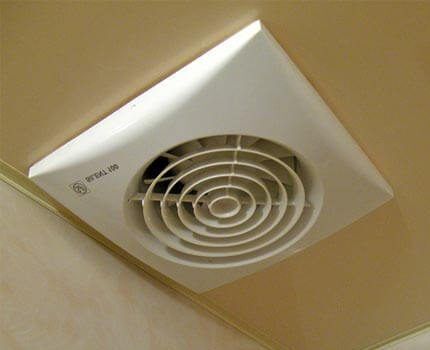
You should also immediately provide openings for air flow. To do this, you can leave a gap of up to 2 cm between the floor and the door, install special grilles at the bottom of the doors to the bathroom and toilet, or drill holes yourself. But the last option does not look the most attractive.
Classification of exhaust fans
When planning the installation of a ventilation system, special attention should be paid to the principle of its operation and individual components. After all, productivity, noise level of equipment, installation cost and durability depend on this.
For forced evacuation of exhaust air from the room, three types of fans are used:
- diametrical;
- axial;
- radial.
The first type of devices is designed to work in heat guns and air conditioning systems. Therefore, it is not suitable for organizing ventilation in the bathroom and toilet. It remains to choose from two other types.
The main difference between axial models and radial ones is their low cost and high power. But the device will make quite a lot of noise. An axial fan is an impeller to which blades are attached. The system is driven by an electric motor.
As for radial units, their operation is based on the action of centrifugal force. Due to the rotation of the impeller together with the blades, air masses move.
In this case, you can change the inclination of the blades, thereby reducing the amount of energy consumed by the device and reducing the level of noise it produces. With popular models silent fans, intended for installation in bathrooms, will familiarize you with the article recommended by us.

Basic criteria for choosing equipment
Manufacturers offer a simply huge range fans for exhaust systems. Therefore, it is not surprising that every unprepared buyer falls into a stupor and does not even know what he should order.
When buying an exhaust device for the bathroom and toilet, you need to pay attention to the following points:
- Duct diameter. Depending on this characteristic, the fan pipe is selected. As a rule, standard models have a diameter of 150, 125 or 100 mm.
- Presence/absence of air ducts, as well as their location in the room. These criteria influence where the fan will be installed.
- Power. Characteristics are important when choosing, so that in the future the exhaust equipment copes with the functions assigned to it.
- Presence of moisture protection. This indicator is marked with the Latin letters IP. The minimum required value for a plumbing unit is IP30, but it is better to spend a little money and order a device with IP44. In the latter case, it will be located in a special sealed casing, protected from moisture and splashes.
- Noise level. Few people pay due attention to this important characteristic, but in vain. After all, a silent exhaust system will make being in the bathroom and toilet more comfortable.
Taking these subtleties into account, you can choose a model that will be inexpensive and satisfy all your wishes.
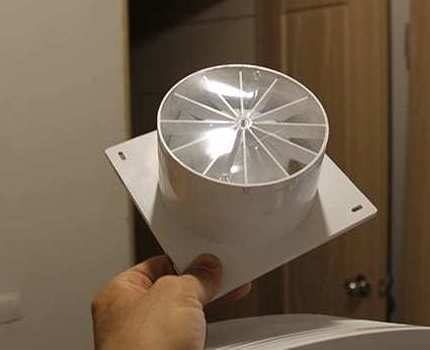
Additional equipment functions
An excellent solution would be to order a fan with additional functions. Most often, buyers prefer models with a built-in timer.
In this case, the user can leave the factory settings or program the operation of the device independently, changing the operating time, start delay, etc. Thanks to this, it is possible to automate the process of ventilation of the toilet and bathroom.
Devices with a built-in timer are quite expensive. Therefore, their choice should be taken with full responsibility. Products from Maico have proven themselves best.This manufacturer offers a number of models that are equipped not only with a timer, but also with other additional functions.
Fans that allow you to switch the base load will help save energy. That is, the unit can operate in two modes: half its capacity and full power, when you need to refresh the air in the room in the shortest possible time. Thanks to this function, the noise of the ventilation system is significantly reduced and energy is saved.
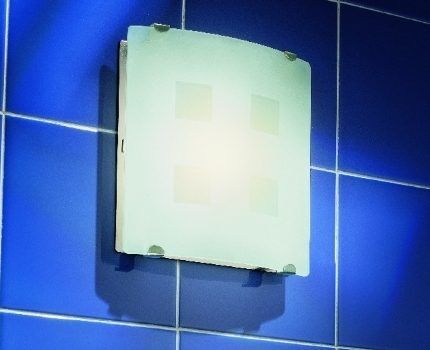
Any specialist will prefer a device with a built-in humidity sensor. Its peculiarity is that it turns on only by a signal from the built-in hygrometer. Thanks to this function, energy is saved and there is no need for a separate electrical outlet for the fan or connecting the device to a light switch.
System components and materials
Today, ventilation is assembled from air ducts round or rectangular cross-section. As a rule, they are made of metal or plastic. These elements are mounted behind a suspended ceiling.
If we are talking about bathrooms and toilets in a small apartment, then in such housing the ventilation duct is a hole in the wall into which a fan is inserted. In this case, there is no point or need to design a complex, branched system.
As for private houses, ventilation for them is constructed from the following elements:
- Air ducts. It is much more convenient to install rectangular air ducts. They fit compactly under the ceiling and do not take up extra space.These are pipes whose length can be 2, 1 and 0.5 m.
- Fan. A surface-mounted or built-in device is used. The latter type is best used in branched and complex systems. Overhead models are recommended for ventilating one room.
- Swivel elbows. In the case of rectangular pipes, the rotary bends can be vertical or horizontal.
- Couplings. These elements are used to connect straight sections of the ventilation system.
- Check valves. They are designed to prevent air and insects from entering the mine.
During the installation process you will also need fastenings. It is much more convenient to use ready-made elements. They will greatly simplify the installation process and speed up the work.
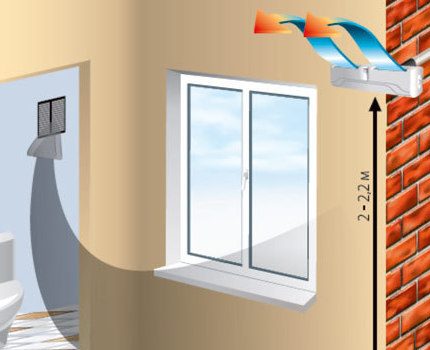
In case of an error in the design or insufficiently efficient operation of the ventilation system in the bathroom and toilet of a private house, the problem can be eliminated by installing exhaust ventilation valve into the wall. Features of choosing the specified device and installation rules are given in the article, the contents of which we advise you to familiarize yourself with.
Installation of ventilation in the bathroom and toilet
Before starting installation work, it is necessary to carry out preparatory work. First of all, you need to compare the diameter of the exhaust device with the size of the shaft.
If the ventilation hole is large, then a plastic pipe or corrugation is inserted into it. In this case, the voids should be sealed using polyurethane foam. If the entrance to the ventilation shaft is smaller, it can be expanded using a hammer drill.
Determining the installation location
For forced ventilation to be as effective as possible, it is not enough just to purchase powerful equipment. It is equally important to choose the right installation location.
Because extractor hood in the bathroom is designed to remove hot, humid air, the optimal solution would be to install it in the upper part of the wall, which is located opposite the door.
It is important to organize the flow into the room - you will have to build a special grille into the lower part of the door or leave a regular gap under the door (a more economical way). These options will allow fresh air to flow from the living space into the bathroom.
Diagnostics of the condition of the ventilation duct
If you are thinking about remodeling a bathroom or toilet, then before starting any work you should carry out diagnostics of ventilation ducts in ways accessible to owners.
First of all, the traction is checked, for which a sheet of plain paper, a lit match or a lighter is leaned against the shaft. If the paper sticks to the ventilation grille and the flame tilts towards the duct, then this is a good sign.
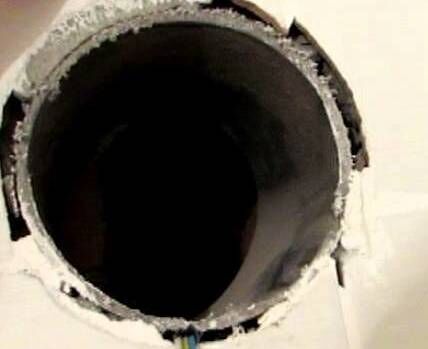
Selecting a device connection diagram
If we consider a standard apartment in a new building, then in the vast majority of cases natural ventilation is not enough to remove all excess moisture from the bathroom. The only exception is a private house, the toilet of which has a window.
But when installing forced ventilation, the question is: how long should the exhaust device work? Often apartment owners connect the fan to the light switch. This means that the device will be able to work exactly as long as a person is in the bathroom. This may not be enough.
The second method is based on connecting the fan to a separate switch. But in this case, the user will forget to turn on/off the device. Therefore, a suitable solution would be to install a fan with a humidity sensor. Such devices operate autonomously and remove excess moisture from the bathroom without human intervention.
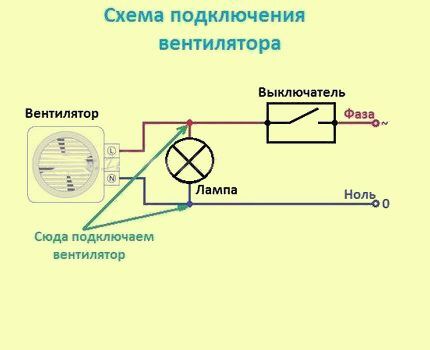
Fan installation details
Before you begin installing the ventilation system, you must read the instructions that come with the devices. In the vast majority of cases, the entire installation process is described in detail in the insert. This will greatly simplify and speed up the work.
The most labor-intensive stage is installing and connecting the fan.
If there are no manufacturer’s recommendations or there is no translation into your native language, then you should perform the actions in the following sequence:
- Remove the front cover.
- In those areas where the fan is adjacent to the wall, it is necessary to apply polymer glue, silicone or liquid nails. All of the above mounting methods are perfect, since exhaust devices are most often made of plastic and, accordingly, are light in weight. Therefore, liquid nails will be enough.
- Insert the fan so that its working part (electric motor and wheel with blades) is completely “recessed” into the wall.
- Press the unit body tightly so that the adhesive has time to set.
- Install a mosquito net. This element will protect against various insects and debris from entering the room from the ventilation duct.
- Secure the front cover using self-tapping screws or dowels that are included in the kit.
The final stage is laying the cable and connecting the ventilation system to the electrical network.
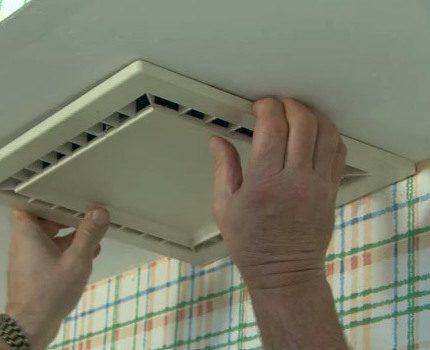
Forced ventilation significantly increases the volume of air removed from the room. But since the front cover blocks a considerable part of the channel when the device is turned off, the flow rate decreases several times. Because of this, its performance drops significantly.
The above problem is solved by installing an air intake grille. This will help restore normal performance. The second method is to leave a small gap (1-3 cm) between the front cover and the wall. Air will be sucked into the resulting gap and ventilation will operate normally.
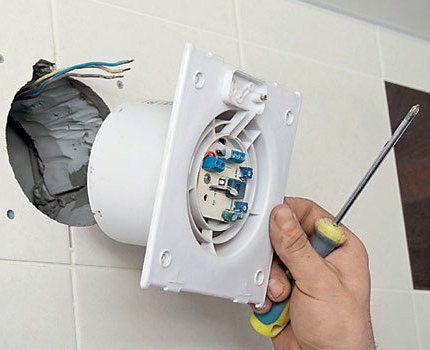
Common installation mistakes
If an inexperienced craftsman is installing a ventilation system, then situations often arise when, after finishing the work, its performance does not satisfy the wishes of the residents or it is not efficient.
The reason for this is due to errors during installation. To avoid basic problems, you need to know some nuances.
The most common errors encountered when installing a ventilation system are:
- the channel is designed incorrectly, which significantly impedes the movement of air;
- fans make a lot of noise when operating;
- the tightness of the shaft connection is broken;
- The ventilation system passes through the living space and its noise interferes with the normal life of the family.
If the design was not done correctly, then the problems listed above will certainly appear. However, to correct them, it is often necessary to completely redo the ventilation system.
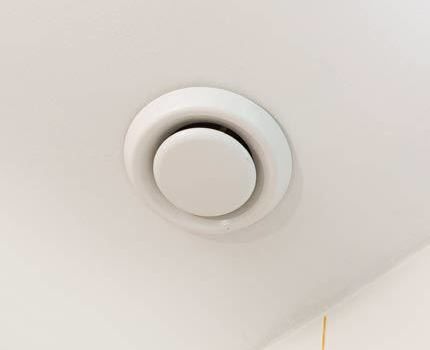
You can go the easy way. For example, to reduce noise, it is recommended to use noise absorbers. As for increasing ventilation performance, to do this you will have to install a new, more powerful exhaust device and check the quality of the air flow into the bathroom and toilet.
Recommendations from experienced specialists
It will be useful for people who are encountering the organization of ventilation in the bathroom and toilet for the first time to familiarize themselves with tips from experienced professionals.First of all, they recommend ensuring a normal flow of fresh air into the room. Otherwise, the operation of the exhaust fan will be meaningless.
There is no need to buy expensive and bulky systems. Spending enormous amounts of money is not always the best solution. It is enough to select the devices correctly and competently, then even cheap models will cope perfectly with the ventilation of the room.
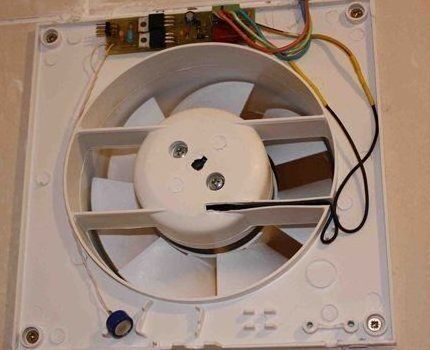
If the house has an air conditioner, ionizer, purifier, household humidifier and similar devices, then it is still necessary to install ventilation. After all, none of the devices listed above provides a flow of fresh air into living spaces.
Rules for operating the exhaust system
In order for the equipment to serve as long as possible, it is necessary to regularly carry out preventive maintenance. After all, dust and dirt accumulate on the fan blades over time. This does not allow the device to work at its maximum capabilities and provide decent air exchange. Moreover, if cleaning is not carried out in a timely manner, the device may fail.
Preventive maintenance includes regularly inspecting the ventilation system for blockages and washing the fan blades. This approach will allow you to always breathe fresh and clean air even in a modern house, which is highly airtight.
Conclusions and useful video on the topic
Video #1: Secrets of installing hoods in the bathroom and toilet:
Video #2: Creating separate ventilation in the bathroom and toilet:
Installing a forced ventilation system allows you to solve the problem of room ventilation, which is pressing for modern houses and apartments. A window is rarely installed in bathrooms and toilets, so the only correct and reasonable solution would be to provide intensive air exchange artificially by installing a fan in the system.
Would you like to share your personal experience in arranging ventilation in an adjacent bathroom or a separate bathroom? Do you have interesting information that will be useful to site visitors? Please write comments, ask questions, post photos on the topic in the block below.




In general, ventilation plays an important role in the bathroom, so we approached this matter responsibly. We live in a private house, and we didn’t really want to install a window. Experienced craftsmen were called in for this. The exhaust hood was forced, and when the lights are turned on, it also starts working. There is now almost no moisture in the bathroom, we don’t see mold, but it took a lot of money.
I didn’t worry too much, didn’t calculate the size of the room, etc. The characteristics of the fans indicate how much area they can cover, and this is quite enough, especially if the bathroom is typical. I bought an axial fan with a timer; it turns on several times a day for 10 minutes. This is enough to keep the air fresh, but little electricity is consumed and the noise of the blades does not interfere.